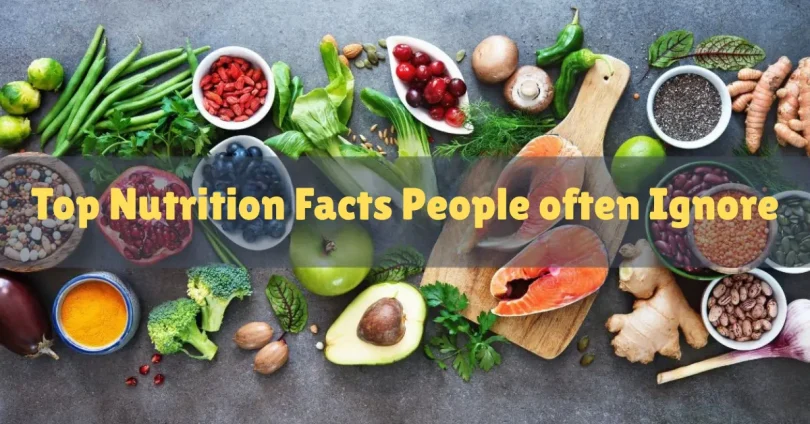In today’s fast-paced world, most people glance at calories, fat, or protein when checking food labels. However, Top Nutrition Facts People Often Ignore tell a much deeper story about what we consume and how it affects our health.
Ignoring these details can impact energy levels, long-term health, and overall wellness. Understanding these facts allows you to make smarter food choices, maintain balanced nutrition, and prevent chronic diseases.
1. Serving Size Isn’t What You Think

One of the most frequently overlooked Top Nutrition Facts People Often Ignore is the serving size. Many assume that the nutrition numbers on a package represent the entire product, but they usually refer to a smaller portion.
- Example: A bag of chips may list 150 calories per serving, but the bag may contain 3–4 servings. Eating the whole bag could mean consuming 450–600 calories without realizing it.
- Why it matters: Misreading serving sizes can lead to overeating, unintentional sugar and fat consumption, and weight management issues.
- Tip: Always check the serving size and calculate nutrition based on how much you actually consume, not the whole package.
2. Added Sugars Are Everywhere
Another critical aspect in Top Nutrition Facts People Often Ignore is added sugars. Unlike natural sugars found in fruits or dairy, added sugars are incorporated during processing and offer little to no nutritional value.
- Health impact: Excessive added sugar contributes to obesity, diabetes, and heart disease.
- Hidden sources: Soft drinks, flavored yogurts, cereal, sauces, and even bread can contain high amounts of sugar.
- Tip: Check labels for “added sugars” and aim to keep them under 10% of your total daily calories. Opt for whole fruits for natural sweetness instead of processed sweets.
3. Sodium Levels Can Be Hidden
Many people focus on taste when it comes to salt, but hidden sodium is a major concern—one of the Top Nutrition Facts People Often Ignore.
- Health impact: High sodium intake increases the risk of high blood pressure, kidney disease, and heart complications.
- Hidden sources: Processed meats, canned soups, sauces, bread, and even some cereals may contain high sodium.
- Tip: Always check the sodium content per serving and compare products to choose lower-sodium options. Cooking at home and using herbs or spices instead of salt can also reduce sodium intake.
You may also like to read this:
What Nutrition Facts Mean on Food Labels – Complete Guide
How To Read Nutrition Facts Properly: Full Guide
Types of Hidden Ingredients In Processed Foods You Must Know
Why Calories on Labels Can Be Confusing Explained
Best Apps To Check Nutrition Facts For Healthy Eating
4. Fiber Is Underappreciated
Fiber is essential for digestion, heart health, and blood sugar control, yet it is often overlooked—another common example in Top Nutrition Facts People Often Ignore.
- Sources: Whole grains, vegetables, fruits, legumes, and nuts are rich in fiber.
- Health benefits: Fiber regulates bowel movements, lowers cholesterol, supports a healthy gut, and keeps you feeling full longer.
- Tip: Aim for 25–30 grams of fiber daily. Incorporate high-fiber foods into every meal, and consider swapping refined grains for whole grains.
5. The Type of Fat Matters
Not all fats are harmful, but ignoring fat type is one of the Top Nutrition Facts People Often Ignore.
- Healthy fats: Unsaturated fats from olive oil, nuts, seeds, and fatty fish improve heart health and support brain function.
- Unhealthy fats: Trans fats and excessive saturated fats increase the risk of heart disease and inflammation.
- Tip: Avoid trans fats entirely and limit saturated fats. Include healthy unsaturated fats in your diet for better overall health.
6. Calories Are Not the Whole Picture
Calories measure energy but don’t reflect nutrient quality, making this a key point in Top Nutrition Facts People Often Ignore.
- Example: 200 calories from candy provide sugar with minimal nutrients, while 200 calories from almonds provide fiber, healthy fats, and protein.
- Tip: Prioritize nutrient-dense foods over empty-calorie options to fuel your body efficiently and maintain health.
7. Micronutrients Are Often Ignored

Vitamins and minerals—like calcium, iron, potassium, and vitamin D—are essential but frequently neglected in Top Nutrition Facts People Often Ignore.
- Health impact: Micronutrients support bone health, immunity, metabolism, and overall body function.
- Tip: Eat a variety of colorful fruits, vegetables, whole grains, lean proteins, and dairy to meet your daily micronutrient needs. Don’t rely solely on fortified processed foods.
8. Sugar Alcohols and Hidden Carbs
Sugar alcohols, common in “sugar-free” or “low-carb” foods, are often ignored—another important entry in Top Nutrition Facts People Often Ignore.
- Impact: Can cause bloating, gas, or diarrhea in sensitive individuals, and some sugar alcohols may slightly affect blood sugar.
- Tip: Read labels carefully, especially if monitoring carbohydrates or digestive health. Moderation is key.
9. Cholesterol Isn’t the Enemy
Dietary cholesterol has long been feared, but research shows it is one of the Top Nutrition Facts People Often Ignore. Cholesterol in food has less effect on blood cholesterol than saturated and trans fats.
- Tip: Enjoy eggs, lean meats, and dairy in moderation. Focus on a balanced diet and overall nutrient intake rather than cholesterol alone.
10. Ingredients List Tells the Full Story
The ingredients list is often neglected, making it one of the Top Nutrition Facts People Often Ignore.
- How it works: Ingredients are listed in descending order by weight, with the first few being the most abundant.
- Warning signs: Long lists of artificial additives, preservatives, sugar, or sodium usually indicate less healthy options.
- Tip: Choose foods with simple, recognizable ingredients. The shorter the list, the better.
Practical Tips to Apply Top Nutrition Facts People Often Ignore
Understanding nutrition labels is one thing, but applying the knowledge is another. Here are actionable tips to help you use these Top Nutrition Facts People Often Ignore to your advantage:
- Plan Your Meals Ahead
- Check nutrition labels when grocery shopping and plan meals that meet your nutritional goals.
- Example: Choose cereals with high fiber and low added sugar for breakfast instead of processed sugary options.
- Check nutrition labels when grocery shopping and plan meals that meet your nutritional goals.
- Compare Products
- Not all brands are created equal. Comparing products helps you choose the healthiest option.
- Look for lower sodium, higher fiber, and minimal added sugars when comparing similar products.
- Not all brands are created equal. Comparing products helps you choose the healthiest option.
- Cook at Home When Possible
- Cooking at home lets you control ingredients and portion sizes, reducing hidden sodium, sugar, and unhealthy fats.
- Use herbs, spices, and natural sweeteners like honey or maple syrup instead of processed sauces and condiments.
- Cooking at home lets you control ingredients and portion sizes, reducing hidden sodium, sugar, and unhealthy fats.
- Use Nutrition Apps or Tools
- Apps that scan barcodes can quickly show you nutrition details, including hidden sugars, sodium, or fats.
- This is particularly helpful for people who want to monitor micronutrients or macronutrients accurately.
- Apps that scan barcodes can quickly show you nutrition details, including hidden sugars, sodium, or fats.
- Read Labels for Hidden Ingredients
- Beyond calories and macros, check for artificial additives, preservatives, and sugar alcohols.
- The shorter and simpler the ingredient list, the healthier the product usually is.
- Beyond calories and macros, check for artificial additives, preservatives, and sugar alcohols.
Common Mistakes People Make Regarding Nutrition Labels
Even when people read labels, many still make mistakes. Recognizing these common errors will help you apply Top Nutrition Facts People Often Ignore more effectively:
- Assuming “low-fat” equals healthy: Low-fat foods may be high in sugar or refined carbs. Always check the full nutrition panel.
- Overlooking portion sizes: Eating multiple servings unknowingly can double or triple your calorie and sugar intake.
- Ignoring micronutrients: Vitamins and minerals often get ignored, even though they are essential for long-term health.
- Trusting “sugar-free” blindly: Sugar alcohols can still impact digestion or blood sugar.
Foods That Often Mislead People
Certain foods are notorious for misleading nutrition labels. Being aware of these is part of knowing Top Nutrition Facts People Often Ignore:
- Breakfast Cereals: Often marketed as healthy but may contain high sugar and low fiber.
- Granola Bars: Packed with sugar and calories, despite “natural” labeling.
- Low-Fat Yogurts: Often have added sugar to improve taste.
- Canned Soups: High in sodium despite appearing light.
- Packaged Smoothies: Can have hidden sugar and calories, especially fruit blends.
The Bigger Picture: Holistic Nutrition Awareness
Focusing solely on calories or macronutrients is limiting. The Top Nutrition Facts People Often Ignore emphasize a more holistic approach:
- Balance macronutrients (protein, fat, carbs) with micronutrients (vitamins, minerals).
- Include fiber-rich foods for digestive health and satiety.
- Monitor added sugars, sodium, and unhealthy fats to reduce long-term health risks.
- Pay attention to ingredients and processing—whole foods are usually superior to heavily processed options.
By applying these principles, you can make smarter food choices that not only satisfy hunger but also promote sustained energy, better metabolism, and overall wellness.
Final Thoughts
Awareness of Top Nutrition Facts People Often Ignore empowers you to take control of your diet and health. Labels are more than numbers—they are a roadmap to understanding what goes into your body.
Next time you shop, cook, or eat, remember to read beyond calories, fat, and protein. Pay attention to serving sizes, added sugars, sodium, fiber, fat types, micronutrients, sugar alternatives, cholesterol, and ingredients. Being mindful of these often-overlooked facts will help you make informed decisions, maintain consistent energy, and support long-term health.
FAQs
1. What are the most commonly ignored nutrition facts?
Many people focus only on calories, fat, and protein. Other crucial nutrition facts often ignored include serving size, added sugars, sodium, fiber, type of fat, micronutrients (vitamins and minerals), sugar alcohols, and ingredients lists.
2. Why is serving size important?
Serving size determines how much of the nutritional content you are actually consuming. Ignoring it can lead to overeating and unintentional intake of excess calories, sugar, or sodium.
3. How can I identify added sugars on labels?
Look for the term “added sugars” on nutrition labels. Ingredients like cane sugar, corn syrup, high-fructose corn syrup, and honey are common added sugars. Limiting added sugars to less than 10% of daily calories is recommended.
4. Are all fats bad for health?
No. Unsaturated fats (found in olive oil, nuts, seeds, and fish) are healthy and beneficial for the heart and brain. Unhealthy fats, such as trans fats and excessive saturated fats, can increase the risk of heart disease.
5. How much fiber should I consume daily?
The recommended daily intake for adults is 25–30 grams of fiber. High-fiber foods include whole grains, vegetables, fruits, legumes, nuts, and seeds. Fiber helps with digestion, blood sugar control, and satiety.





